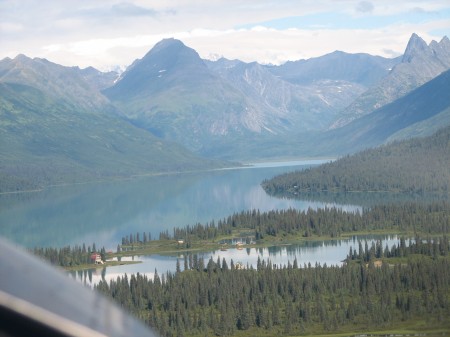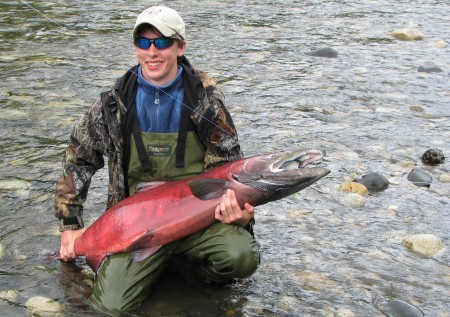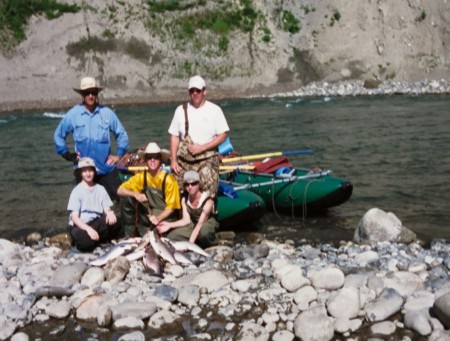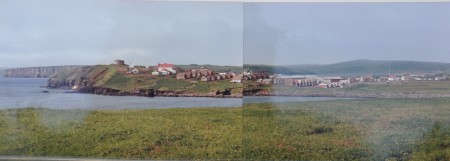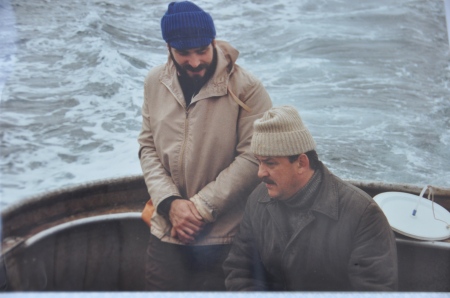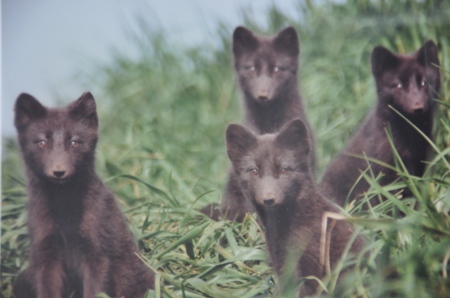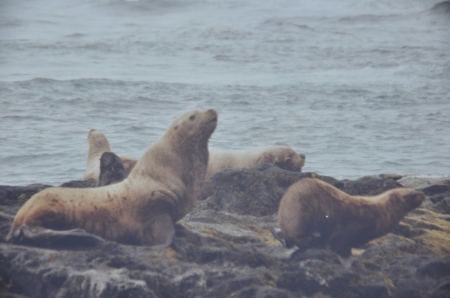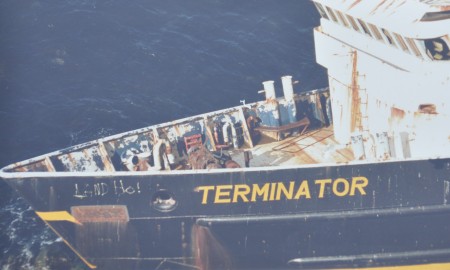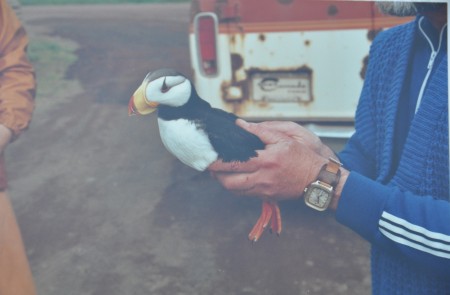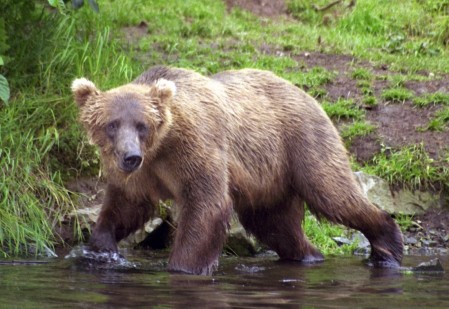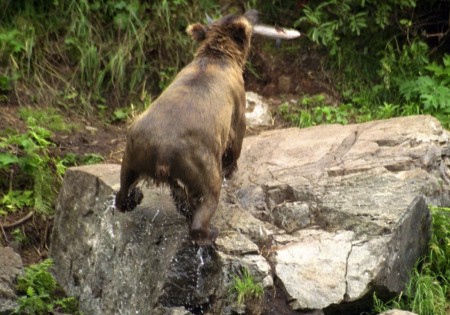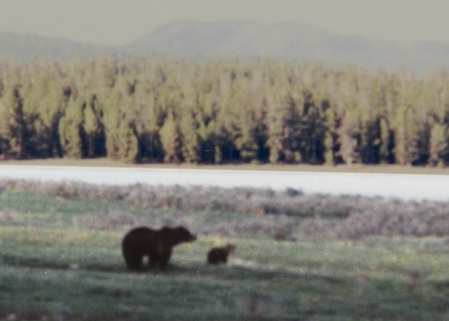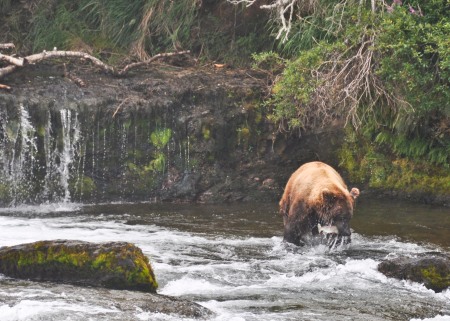Lessons in living in the wilderness but living abundantly
It’s not about surviving
Many books exist about humans surviving in the wild, of men who went for days without food, or were shipwrecked on islands for months or even years. TV shows like Man vs. Wild and Survivor Man have been popular in recent years. Survival though, is something wild animals naturally do, but people only do in desperate situations. God however, wants us to do more than simply survive, he wants us to live. God sent His son, Jesus Christ, to save the world, and give people an everlasting and abundant life. And when we study Scripture, we learn God wants us to do much more than hunt for scraps! He has not made us to be like the animals, for He has made us in His image, and has called us to take dominion over His creation, to “fill the earth and subdue it” (Genesis 1:28). Such messages are often shocking to unbelievers as well as believers swayed by secular opinions, especially regarding population control. In the last hundred years, humans have killed other humans at alarming rates and for stupid reasons, with over 100 million murdered at the hands of communist dictators, and almost as many babies murdered while still in the womb. Many Christians have also become lukewarm on the issue of homosexuality, a sinful lifestyle choice which emphasizes extreme selfishness. Not only that, it is a “sterile” lifestyle, with a birth rate of 0.0.
On the opposite extreme, Christians sometimes mistake their own selfish feelings with God’s command to “be fruitful and multiply”. Without considering the cost, they produce large families they cannot support, and become slaves to debt as they struggle to survive. A family in this position is often much more likely to sin against their neighbor as they find ways to provide for their family. It does not help though, that governments do not celebrate large families, but instead find ways to tax them.
In the United States, there are some tax breaks for families with children, but they are not near enough. Governments should never make laws limiting the number of children a family can have, but they can encourage citizens to be responsible and follow Christian principles such as abstinence, marrying one spouse, and discouraging divorce. All governments should remember the simple fact that in order to have an economy, you need people. Russia, a country trying to recover from the depopulation brought on by years of rule by atheist dictators, understands this. In 2006, Vladimir Putin enacted a policy whereby families would receive $10,000 USD for having a second child. Ultimately though, the only incentive a family really needs for having children is God’s word.
If you are a young person, consider some day that you and your peers will inherit the land your parents once lived in and ruled. What will you do then? I hope you will choose to live an abundant life, and to ensure that both human life and all life prospers under your reign. It would be good for you to apply Christ’s parable of the talents (Matthew 25:14-30). Be like the servant who, when given 5 talents, went and earned 5 more. This is the proper view of Christian living. Don’t be like the wicked, lazy servant who, receiving 1 talent, went and hid it in the ground. The proper Christian ethic is that when you are given something, whether it is money, an education, the ability to have children, or other gifts, don’t hide it in the sand, but wisely use it and multiply it.
And, when you venture into wilderness, apply the parable of the talents as well. Go with the mindset of doing more than just surviving. But before you go, you must gain some talents of your own, the most important of which include knowledge and experience, physical fitness, and proper supplies.
Hold onto instruction
In Proverbs 4:13, King David exhorts us to “hold onto instruction, do not let it go, guard it well, for it is your life”. While the most important instruction for a Christian is to learn and apply what God said in the Bible, we should also study what God made. Francis Bacon, the founder of the scientific method, couldn’t have explained it more clearly when he said
A man cannot be too well studied in the book of God’s word or the book of God’s works.
Before preparing for an adventure of any type, it is good to read as much as possible about His works. Probably the most important study that you can do is about plant and animal life. Field guides are an excellent source of information. One of Adam’s first “jobs” was to name the animals, and God probably did this so that Adam would build a relationship with His creation, and as a result, feel a greater responsibility and respect for it. Likewise, studying field guides will allow you to learn many things that you did not know, and when you start your wilderness adventure, you will have a greater respect for and enjoyment of your surroundings.

Field Guides are helpful before and during any wilderness adventure. Copyright 2005, Kip Lutz
For any adventure into Alaskan wilderness, you will want to know as much as you can about edible plants. There are many salmon streams in Alaska that you could float down and live off of berries and salmon, just like the grizzlies do. Think about it; if the salmon stream ecosystem has enough food to support one or more grizzly bears, then it has enough food to support you! A good field guide that you should plan to bring is Alaska’s Wild Plants by Janice J. Schofield. Most of us are so conditioned to purchasing edible plants from the grocery store, we almost think that is where plants come from. Others may think edible plants only grow on farms. Of course, edible and poisonous plants grow in the wild, which is why a field guide is such a valuable resource before and during the adventure.

Twisted stalk, a watermelon-flavored berry common along the banks of Lake Creek. Copyright 2005, Kip Lutz.
And in Alaska, what an abundance of fruit there is! Along the banks of Lake Creek in late July and early August, twisted stalk and highbush cranberries abound. These are also favorites of bears, as evidenced by the seeds and undigested berry skins present in their scat. Less common are currant berries, cloudberries and raspberries. Fireweed is everywhere, and its flowers and leaves are edible. Have a headache? Grab a few leaves off a willow tree and start chewing. Willow leaves contain a natural pain reliever, salicylic acid. A derivative of it, acetylsalicylic acid, is the active ingredient in aspirin.
Our favorite Alaskan berry is the blueberry. On Lake Creek their preferred habitat is in open forest on the tops of drumlins, hills formed by glacial movement centuries before. Hiking into the woods along bear and moose trails, we would find literally buckets of blueberries. Several varieties of blueberries exist in Alaska, and the variety along lower Lake Creek consisted of 3-4 ft tall bushes. We ate many of the blueberries raw, but also mixed them with oats, sugar and butter to make a delicious blueberry cobbler.
Other field guides to study before and during a trip down Lake Creek or other Alaskan rivers include guides on birds, fishes, and wildlife. Alaska Pocket Guides, published by Alaska Northwest Books, are excellent resources. Use the guides as a springboard into learning about a particular species, and then if you want to learn more, search the internet or visit a local library. Of course you will want to learn as much as you can about grizzly and black bears, but as you study the guides, you will quickly realize that there is more to Alaska than bears and salmon. Another worthwhile guide is Trout Stream Insects, by Dick Pobst. This is a very helpful guide for learning about the abundance of aquatic invertebrates found in Alaskan streams.
A final field guide you might consider is the Golden Guide on Geology from St. Martin’s Press. Besides Alaska, there are few places in the world with such a variety of geological features, including mountains, glaciers, and volcanoes. Fossils are relatively easy finds, and in many streams, including Lake Creek, you can still pan for gold. In his ingenuity, our outfitter provides us with plastic serving bowls which are actually designed for gold panning.

These bowls serve a dual purpose of either gold panning or holding the evenings meal of rice and Northern pike. Copyright 2005, Kip Lutz.
It’s okay to be wet!
A normal part of most summer days in coastal Alaska is rain. Where I am from in Texas, outdoors activities are typically postponed on account of rain, but not in Alaska. In order to truly enjoy Alaska, one must welcome the rain as easily as they would welcome a sunny or cloudy day. Nevertheless, this does take some getting used to. On our first Alaska Science Adventure Camp in 2002, we had almost no rain until the last night. The following year was different. For the first three days, it rained almost non-stop. A longtime friend, Mike Boriack had come along on this trip, bringing his oldest son John. Mike and John are avid hunters and fishermen, but like all of us, were used to staying inside when it rained. When you go on trips like this that test your limits, you learn things about people you didn’t realize. Mike is one of the most faithful Christian men I know, and I realized that even more on this trip. James 1:2-3 teaches us how we are to be joyful amidst our trials, and it is definitely more difficult to live in the rain, especially outdoors for three straight days! So on that third evening, after rafting through the rain all day, as we were setting up camp Mike loudly proclaimed, “you know what I’ve learned, that it’s okay to be wet!”

Campers acclimated to Alaska's summer rain sit by a fire, while others prepare the evening meal under a makeshift rain fly. Copyright 2005, Kip Lutz.
This encouraged all of us, and simple lessons like those are great for young people to learn at an early age. Often, when we are faced with a new situation, we have two choices to make; either let it get the best of you, or persevere and be better off for it. Unfortunately, perseverance does not come naturally, but as James teaches, if we count our trials as joy, we will develop perseverance, and become mature and complete. All Christian parents long to see their children mature and complete in Christ, and since God has given parents the responsibility for raising children, it is up to them to allow their children to work through trials. Of course, wisdom must be applied, and you don’t send your son or daughter out into the Alaskan wilderness without a raincoat and waterproof bag full of dry clothing, hoping he’ll “pass the test”. The goal is not to see if they will live or die, but to give them a little more to handle than they are used to.
The great thing about most trials is that after you go through them, you realize they really were not as bad as you expected, and that your main problem was that you were letting them get the best of you instead of counting them as joy and understanding that God was trying to teach you something through your trial. I have definitely learned a lot about persevering through less than pleasant weather conditions in Alaska, and I now actually look forward to the challenge of inclement weather, rather than immediately running from it.
What to bring
On a wilderness trip in Alaska, expect some trials, but most importantly, be wise and plan well. Knowledge, experience and prayer become important. And when you think about it, if you compare a group of uneducated, inexperienced heathens to a group of educated, experienced Christians, it is easy to see who would get more out of a trip to Alaska, and more out of life! Thomas Jefferson saw the importance of education and experience when in 1803 he asked the well-educated Meriwether Lewis to lead an expedition into America’s West. And Lewis picked a friend who was an experienced outdoorsman and military leader, William Clark, to help lead the expedition. The famed Lewis and Clark expedition helped shape America’s future, and a National Park and Preserve in Southwest Alaska is named for these two explorers.
Lewis spent months planning and preparing his expedition. Planning is the most important step on any adventure into new lands. To prepare for Alaska camps I read as much as possible about the land before departing, and I encourage the other campers to do the same. On the first Alaska Science Adventure camp, I relied heavily on the camping and outdoors experience of my friend, Jim Kronjaeger, and the knowledge and experience of our pilot and outfitter, Joe Schuster. With their assistance, I learned what worked and what didn’t.
Some of the most important things to bring on an Alaskan float trip include a hooded raincoat, chest waders, and felt-soled wading boots. Waders and raincoats made of breathable material work the best, but are also the most expensive. Breathable waders allow water vapor to pass out, while preventing water from entering. This is important, especially when you are perspiring a lot, as perspiration can collect and even soak your clothing when wearing canvas, vinyl, or other non-breathable rain gear. As longs as you are careful and do not overexert yourself, you should be fine in less-breathable gear, but you do run a greater risk of hypothermia with the extra dampness.

Felt-soled boots can be worn with or without waders, and are great for gripping slippery, algae-coated rocks. Copyright 2005, Kip Lutz.
Some Alaskan fishermen wear hip waders, but on a week-long rafting trip, chest waders are better. As you raft down the river, your raft will get stuck on rocks, and one or more passengers must get out and free the raft. The water surrounding the raft is variable in depth, from knee deep to over chest high. Chest waders come with a “wading belt”, which should be secured and tightened while on the river. In case you fall in and water comes over your waders, the wading belt limits the amount of water that will enter, and often prevents you from becoming completely soaked.
Boots are also important, and as mentioned, felt-soled boots are preferred. If you have never fished rocky streams before, then felt-soled boots may sound really strange. When I first heard of them, I thought “are you serious? Somebody actually sells boots with felt soles? Why?!” However, the felt that is used is not like the felt in your daughter’s craft box. It is much thicker and sturdier, and I have boots that have made it through several-years of float trips and have many more to go.
The purpose of the felt is to help your boot cling to algae-covered rocks. It just doesn’t seem like it would work, but with felt, you dramatically increase the surface of the sole exposed to a rock. And in shallow water, the rocks are almost always covered with a slippery layer of algae. Felt-soled boots don’t completely prevent you from slipping on algae-covered rocks, but the difference is orders of magnitude better than ordinary soles. The felt-soled boots become even more important when you are in strong currents, or if you are less than 150 lbs, as the current sometimes tends to sweep lighter people off their feet.
Another important item is the tent. Our outfitter has always provided us with Cabela’s Alaskan Guide 6-man tents. They actually comfortably sleep 4 men on cots, and cots are pretty important because most camping is done on rocky gravel bars. When camping in bear country it is important to camp in an open area, which prevents surprising a bear, and also gives a predatory bear fewer places to hide. Camping in an open area like a gravel or sand bar also leaves the land less-disturbed. Our outfitter provided us with lightweight aluminum-framed Roll-A-Cots, which are a little small for my 6’ 3” frame, but were much better than sleeping on rocky ground.
You also want a good sleeping bag, and there are many to choose from. You do not want to bring one that is big and bulky, but one that stuffs to a small size and is rated to keep you warm in temperatures of 32° F (0° C) or lower. I bring a sleeping bag that is rated for 45° F, together with a silk liner, and the combination has kept me warm on the coolest Alaskan summer nights.
One year, I forgot a sleeping bag. The first problem was that the airlines lost my luggage. It was expected the following day, but my float plane was scheduled to leave that evening, and I could not wait. I made a trip to Sportsman’s Warehouse, and purchased everything that I thought was in that suitcase, but forgot the sleeping bag! Of course, the first night was almost always the coldest, as it was at the highest elevation. I just wore some extra clothes and everything seemed fine, but about 4 hours later the cold set in and woke me up. I searched for more clothes, but did not want to disturb the other campers too much. I curled up into the tightest fetal position a 40-year old man possibly could, and slept fitfully for a few more hours. In The Wilderness Hunter by Theodore Roosevelt, America’s 26th president described sleeping outside in sub-freezing weather, wrapped in a “buffalo robe”. And I was wishing I had a buffalo robe now! By 4:30 a.m., the sun was already out, and I could not stand it any longer, so I got up and made coffee. Another camper heard me and assumed it was breakfast time, but when I told him what time it was, he staggered back to bed. I had never been so happy to see the sun in my life, and grateful I had not awoken to a cold and rainy day! To warm up, I walked up and down the shoreline of Chelatna Lake, and when the sun was high enough, I found a sunny spot to stop and sip my coffee. I never slept in a sleeping bag that whole trip, but the other nights were warmer, and I dressed with even more clothes than the previous nights, and all was well.
Clothing is another extremely important part of any Alaskan adventure, and I have come to appreciate the warmth and water-repelling characteristics of fleece. On an Alaskan float trip, being wet and cold can be deadly, so bring clothing that will maximize your ability to stay warm and dry. Fleece does better than any other material I am familiar with, and it is also relatively inexpensive. I always bring at least two pairs of fleece long-johns, as well as some gloves and a hood-like covering called a balaclava. A popular myth is that 80% of your heat loss occurs through the head. This may be true if the rest of your body is covered, as your head would be about the only place where heat loss could occur. Whatever the case, keeping your head and neck warm with a balaclava can mean the difference between comfort and peril.
Try to avoid anything made of cotton, and use polyester instead. Cotton is hydrophilic, meaning it readily absorbs water. Polyester is hydrophobic, and repels water, which is ideal when you want to keep moisture away from your body. Bring polyester socks, underwear, t-shirts and long-sleeved fishing shirts. You may want to throw in a cotton t-shirt in case the weather gets exceptionally hot and sunny. For socks, some people like to wear a polyester liner with a cotton sock on the outside. The polyester sock pulls moisture away from the skin, which is absorbed by the cotton sock.
You will also want to make sure your clean clothes and other supplies stay dry. There are many good “dry bags” on the market, and I would recommend storing clothes in Ziplocs or similar bags, and then placing these inside your dry bag.
A hat is also important for keeping the sun off. I prefer a baseball cap, as I can leave it on all the time, and when it rains I just pull the raincoat’s hood over the cap, and the brim serves to keep rain off my face. Always remember, the weather is extreme in Alaska, so be prepared for long, bright, sunny days by bringing sunscreen, chapstick, and sunglasses. If you are a fisherman, polarized sunglasses are essential, as their glare-reducing qualities allow you to see underwater better than regular sunglasses. This is extremely important in clear waters where you can see the salmon and trout, and greatly increases your ability to properly direct your casts.
One thing you will quickly learn in Alaska is that there are lots of mosquitoes. Next to rainy days or falling in the river, mosquitoes are probably one of the biggest trials to endure on an Alaskan float trip. Bring some insect repellent with 100% DEET, even though you may not even use it. Like rainy days, I have also learned to endure the mosquitoes, and I rarely use insect repellent unless the mosquitoes are particularly vicious. I just stay clothed most of the time from head to toe, leaving only my hands, face and neck exposed. I have also used insect-repellent clothing made by Ex-Officio. Their Buzz-Off clothing is treated with permethrin, and I was surprised how well my long-sleeved fishing shirt worked. You can also buy permethrin-based clothing repellents from camping supply companies, and apply the repellent to any of your clothes.
So as part of your Alaska Adventure, expect to get wet, cold, and mosquito-bitten. Maybe that doesn’t sound fun at all, but before you think you really don’t want to have an adventure after all, let’s review what an adventure is. According to Webster’s Dictionary, an adventure is “an undertaking usually involving danger and unknown risks.” Hopefully, getting bit by a mosquito is not your idea of a dangerous and/or unknown risk, but if so, then Alaska will be full of adventure for you! Seriously though, mosquitoes, water, and temperature changes, should not really define your adventure, especially if you prepare accordingly.
Some other items to consider include your camp towel, soap, waterproof matches and a lighter, and other personal items. Foot or talcum powder is essential, and since you won’t be taking a shower for a few days (although you may want to rinse off in the river), apply the powder to feet and other areas that need some dryness. Hand lotion is also very helpful, as your hands will be wet almost all day, and they tend to lose oils that keep the skin soft and flexible. A little lotion can keep them from chapping and becoming sore. A travel packet or two of hand/body wipes are also great to clean up.
And of course, don’t forget a first aid kit! Bring pain killers, plenty of band-aids and gauze, emergency splints, elastic bandage for wrapping sprained ankles, etc. In the Alaska Magnum Bear Safety Manual, bear expert Dr. Stephen Stringham recommends packing a bungee cord or surgical tubing to make a temporary tourniquet, gauze to press against a wound and duct tape or a Velcro strap to hold it in place, and a powder called Urgent QR to assist with coagulating blood. Also bring medicines for digestive problems such as antacids, Pepto Bismol, and laxatives. Coleman makes some mini “survival kits” that contain general first aid plus other survival items such as fishing line and a hook, and matches. An emergency blanket, scissors, extra lighters and waterproof matches round out any well-stocked first aid kit.
What tastes good
Although the goal of my Alaska Science/Adventure camps was never to survive, but to live abundantly, we purposely did not bring enough food. In the relatively untamed wilderness of Lake Creek, we fully expected to find a bounty to harvest, and we were not disappointed. Salmon was the main entrée almost every night. Occasionally, some of the boys would refuse to eat the fish, which I always found to be ridiculous. I have never had much tolerance for “picky eaters”, and was usually not overly sympathetic to them. We were on an adventure, and that meant a culinary adventure as well! It is true that young people have more taste buds than adults, and they are naturally more sensitive to strong tastes. The boys who refused to eat salmon were probably exposed to some bad tasting fish at some point, and therefore assumed all fish had a strong “fishy” taste. However, this is simply not the case with fresh-caught, sea-bright salmon. The key is not to overcook them, which is sometimes difficult to judge properly in a rain shower with swirling winds that constantly alter the camp stove’s temperature.

Salmon, rice, and corn, a hearty streamside meal! Copyright 2005, Kip Lutz
The first order of business is to fillet the fish. Salmon are relatively easy to fillet, and for their size, yield a bounty of tasty meat. I usually bring a standard Rapala stainless steel filet knife along, the inexpensive kind found in most outdoor stores. Don’t forget a knife sharpener. Cutco makes a nice fillet knife with an adjustable blade length. Its sheath has a built-in knife and hook sharpener, a clamp to grip the fish with, and a snap to secure it to a belt.
To fillet a salmon, I begin by placing the head to my left, with the belly facing me. Using a gentle sawing motion, I make a cut immediately behind the pectoral fin and down to the backbone. The cut is made at an angle that begins slightly above and to the left of the pectoral fin and passes down and to the right of the fin. When I feel the vertebrae, I pull back up slightly, and begin cutting and twisting the blade until it is parallel to the backbone. With the knife resting against the backbone, I then continue cutting towards the tail. As I cut, I gently wiggle the blade up and down, which helps keep it positioned along the backbone and maximizes the amount of meat removed. Cut too deep and you cut through the backbone and have difficulty removing the fillet. Cut too high and you miss a lot of meat. When the first side is filleted, flip the fish over and repeat the same procedure.
Always make sure you are cutting in a direction leading AWAY from your body, and make sure no one is standing in the path of your knife in case you slip. If you are a novice, you may even want to consider wearing some fish-cleaning gloves, which not only prevent knife injuries but help you grip the fish. Some people don’t like the salmon skin left on, but I leave the skin on the salmon and remove it after cooking (or eat it). The skin helps hold moisture in and contains fats that help keep the salmon juicy. This technique works well on salmon of about 12 lbs or less. Unless you have a really big knife, the technique will be more difficult on larger salmon, but the general principal of cutting along the vertebrae still holds. Some people also like to cut larger salmon in steaks, which usually yields more meat, but also has more bones to deal with.

Sockeye and silver salmon fillets. Note the beautifully-colored meat. Copyright 2005, Kip Lutz.
Now that you have your salmon filleted, it’s time to eat! Our outfitter provides us with Coleman propane camping stoves and iron skillets. I add enough canola oil to cover the bottom of a skillet, plus a couple of tablespoons of butter. I cook the fish on both sides, until it flakes easily. If it becomes “brittle”, then it is overcooked. I usually add some salt and of course dill, which I think is the best herb for seasoning salmon. A splash or two of white cooking wine also enhances the flavor. I usually served this with a heaping mound of rice or pasta. In later years, we started using quinoa, a high-protein grain similar to rice that is popular in South America. For campers wanting to add a personal touch to their meal, other seasonings, including black pepper, lemon pepper, and Tony Chachere’s Creole seasoning, were always available.
One of our favorite ways to serve salmon is to make a sauce using McCormick’s Creamy Garlic Alfredo Sauce mix. The small and lightweight packets were great for camping, and required butter and milk. We bring along powdered milk, also great for packing compared to hauling gallons of perishable milk around. I would cook pasta along with this, and it never seemed like we could make enough of the sauce, as the boys in particular were especially fond of it.
Another favorite method of eating salmon is not to cook it at all, but instead, to marinate it, along with the roe, in teriyaki sauce. I liked eating raw salmon plain or with a little salt, but after marinating for about an hour in teriyaki sauce, it is heaven! Cut into half-inch thick strips, the teriyaki sauce tenderizes the salmon, and makes it seem like you are eating some sort of juicy berry.
Lunch is our least exciting camp meal, and is designed to be eaten on the go, as we want to spend our daylight hours fishing, and exploring. Trail mix, Cliff bars, and crackers with meat and cheese are standard lunchtime fare, with some fruit thrown in as well.
Oatmeal is a staple on our trips, and is the main course for breakfast most mornings, along with some beef jerky, which is either eaten at breakfast or saved for lunch. We usually prepare sausage, egg and cheese breakfast burritos the first few mornings, but for the rest of the trip, steaming bowls of oatmeal greet bleary-eyed campers. We always bring along plenty of butter to go with the oatmeal, along with raisins, cinnamon and brown sugar. We also use oatmeal to make a delicious fruit cobbler. Typically made from blueberries, we have to switch to crowberries in Katmai National Park, as blueberry bushes are almost nonexistent along the river we rafted. Blueberries are cooked, together with a bit of sugar. A few spoonfuls of flour are dissolved in water and then added as a thickener. This is boiled for several minutes until it begins to thicken. In a separate iron skillet, some butter is melted with a few spoonfuls of sugar and a dash of salt, and then oats are added and toasted for a few minutes. The toasted oats are poured on top of the cooked berries and served. Blueberry cobbler is a highlight of our float trips, and I now make it on a regular basis at home, much to the delight of my family.

Wild blueberries along Lake Creek. Copyright 2005, Kip Lutz.
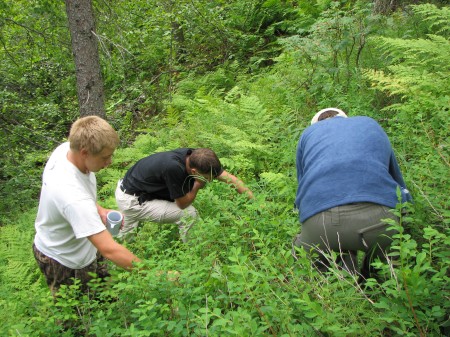
Harvesting the natural bounty of berries. Copyright 2005, Kip Lutz.

Berry-stained hands. Copyright 2005, Kip Lutz.

Serving up wild blueberry cobbler. Copyright 2005, Kip Lutz.
At breakfast and dinner, a hot pot of water is always available for instant coffee or hot chocolate. During the day, we drink filtered water, and we bring plenty of powdered Gatorade to add to it. Some of the boys discovered that hot “Gatorade tea” is actually quite enjoyable on cool evenings. It is important to filter any unboiled water, as surface waters likely contained the microscopic, protozoan parasite known as Giardia. The illness caused by this parasite is called giardiasis, and a popular slang term for the disease is “beaver fever”, named after another of Giardia’s non-human hosts.
The most common manifestations of giardiasis include diarrhea and abdominal pain. Symptoms and signs of giardiasis do not begin for at least seven days following infection, which has occurred for me on more than once occasion. However, I am usually not as careful with my drinking water as I should be, and occasionally drink straight from small streams. And while it tastes wonderful at the time, I sometimes pay for it a week later! As with most illnesses, the young, old, and unhealthy are most susceptible to having a severe reaction to the parasite, and I have been fortunate that my reactions have been very mild. In most cases, giardiasis is self-limiting and lasts 2-4 weeks. The best cure for beaver fever is to follow comedian Tim Hawkins’ advice. According to Hawkins’ a common “cure all” procedure his mother prescribed was “to go sit on the pot”, which is not helpful if you have a broken leg, but is sound advice for sufferers of beaver fever!
So, if you can stand the rain, cold, wet, mosquitoes, bears, and beaver fever, then a week on an Alaskan salmon stream should be right up your alley! Some readers may be thinking “I cannot wait to go!”, while others may be thinking “why would anyone ever want to go?!” But, as I have said earlier, the adventure is not about these things. These are things that you prepare for so that you can have an adventure. And when you do end up cold, wet, and mosquito-bitten with an upset stomach, you either follow James’ advice and count it as joy, or you let it get the best of you and have no adventure at all.

The beginnings of another adventure down Lake Creek. Adventures are things people do that few, if any, have done before. Copyright 2005, Kip Lutz.
Four years of science/adventure camps on Lake Creek taught me a great deal about Alaska, salmon streams, and wilderness camping. By this time, we had many science camp regulars, including Rob Sadowski, Mike and John Boriack, and Troy Finney and his sons, Luke, Sean and Sam. Troy is an amazing outdoorsman, who grew up near Yellowstone National Park. After their second trip down Lake Creek, both Troy and Mike were ready to “take it up a notch”, venturing deeper into Alaska’s wilderness. Lake Creek is a wonderfully remote place, but quite a few people venture to lodges on the Chelatna Lake headwaters, with even more lodges and fishermen at Lake Creek’s mouth. We wanted to find a place that would have almost no people or lodges, and after looking over options, we chose American Creek in Katmai National Park. Known for its remoteness, hordes of sockeye, and large rainbow trout, we were particularly interested in the possibility of seeing many grizzly bears. Some outfitters who floated the river claimed you would see 50 to 70 grizzlies on the 40-mile float. Little did we know that this would turn out to be an extreme underestimate. With our confidence elevated by our successful Lake Creek adventures, we headed boldly on to American Creek. But would we be ready for it, and for the bears that lie ahead?















